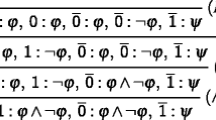Abstract
With the inclusion of an effective methodology, this article answers in detail a question that, for a quarter of a century, remained open despite intense study by various researchers. Is the formula XCB=e(x,e(e(e(x,y),e(z,y)),z)) a single axiom for the classical equivalential calculus when the rules of inference consist of detachment (modus ponens) and substitution Where the function e represents equivalence, this calculus can be axiomatized quite naturally with the formulas e(x,x), e(e(x,y),e(y,x)), and e(e(x,y),e(e(y,z),e(x,z))), which correspond to reflexivity, symmetry, and transitivity, respectively. (We note that e(x,x) is dependent on the other two axioms.) Heretofore, thirteen shortest single axioms for classical equivalence of length eleven had been discovered, and XCB was the only remaining formula of that length whose status was undetermined. To show that XCB is indeed such a single axiom, we focus on the rule of condensed detachment, a rule that captures detachment together with an appropriately general, but restricted, form of substitution. The proof we present in this paper consists of twenty-five applications of condensed detachment, completing with the deduction of transitivity followed by a deduction of symmetry. We also discuss some factors that may explain in part why XCB resisted relinquishing its treasure for so long. Our approach relied on diverse strategies applied by the automated reasoning program OTTER. Thus ends the search for shortest single axioms for the equivalential calculus.
Similar content being viewed by others
References
Belnap, N.: The two-property, Relevance Logic Newsletter 1(1976), 173-180.
Hodgson, K.: Shortest single axioms for the equivalential calculus with CD and RCD, J. Automated Reasoning 20(1998), 283-316.
Kalman, J. A.: A shortest single axiom for the classical equivalential calculus, Notre Dame J. Formal Logic 19(1978), 141-144.
Kalman, J. A.: The two-property and condensed detachment, Studia Logica 41(1982), 173-179.
Kalman, J. A.: Condensed detachment as a rule of inference, Studia Logica 42(1983), 443-451.
Lukasiewicz, J.: Selected Works, edited by L. Borokowski, North-Holland, Amsterdam, 1970.
McCune, W.: OTTER 3.0 reference manual and guide, Tech. Report ANL-94/6, Argonne National Laboratory, Argonne, IL, 1994.
Meredith, C. A. and Prior, A.: Notes on the axiomatics of the propositional calculus, Notre Dame J. Formal Logic 4(3) (1963), 171-187.
Peterson, J. G.: The possible shortest single axioms for EC-tautologies, Report 105, Department of Mathematics, University of Auckland, 1977.
Thiele, R. and Wos, L.: Hilbert's twenty-fourth problem, J. Automated Reasoning, to appear.
Veroff, R.: Using hints to increase the effectiveness of an automated reasoning program: Case studies, J. Automated Reasoning 16(3) (1996), 223-239.
Wos, L., Winker, S., Veroff, R., Smith, B. and Henschen, L.: Questions concerning possible shortest single axioms for the equivalential calculus: An application of automated theorem proving to infinite domains, Notre Dame J. Formal Logic 24(1983), 205-223.
Wos, L.: Meeting the challenge of fifty years of logic, J. Automated Reasoning 6(1990), 213-232.
Wos, L. and Pieper, G. W.: A Fascinating Country in the World of Computing: Your Guide to Automated Reasoning, World Scientific, Singapore, 1999.
Wos, L.: The strategy of cramming, J. Automated Reasoning, accepted.
Wos, L., Ulrich, D. and Fitelson, B.: XCB, the last of the shortest single axioms for the classical equivalential calculus, Bulletin of the Section on Logic, accepted.
Author information
Authors and Affiliations
Rights and permissions
About this article
Cite this article
Wos, L., Ulrich, D. & Fitelson, B. Vanquishing the XCB Question: The Methodological Discovery of the Last Shortest Single Axiom for the Equivalential Calculus. Journal of Automated Reasoning 29, 107–124 (2002). https://doi.org/10.1023/A:1021693818601
Issue Date:
DOI: https://doi.org/10.1023/A:1021693818601




